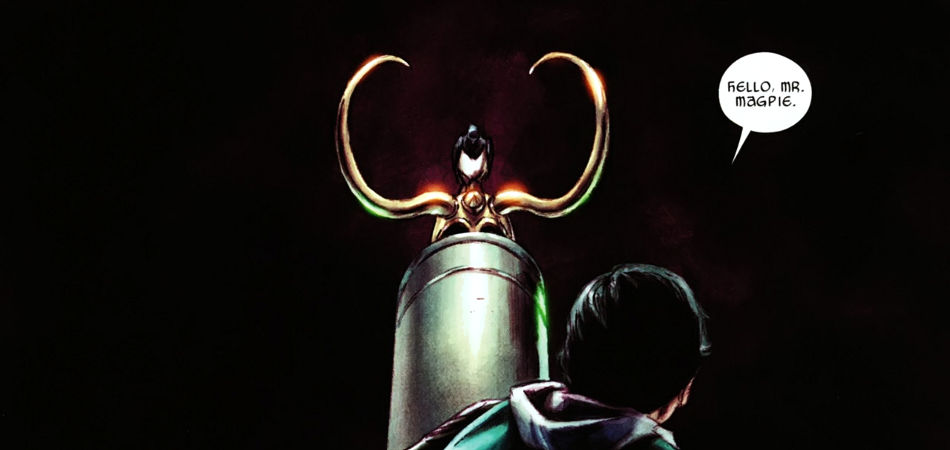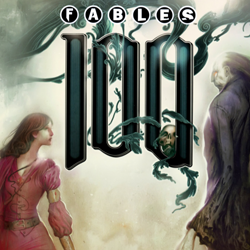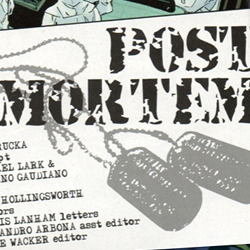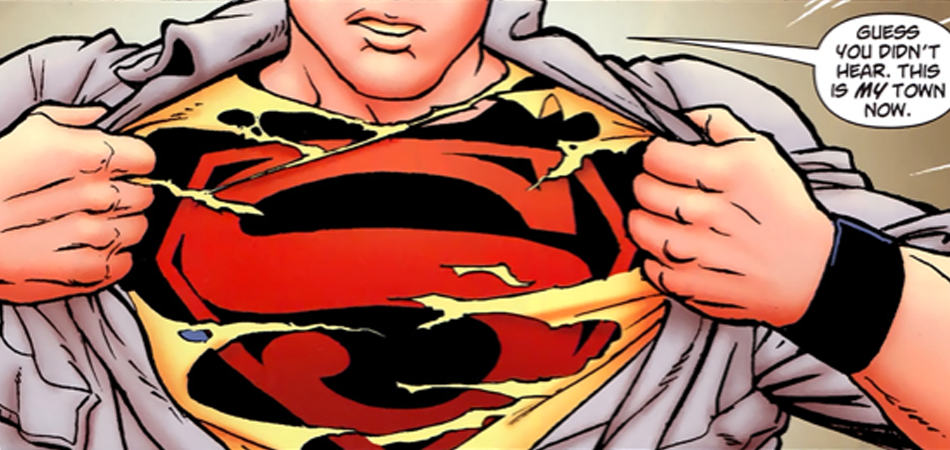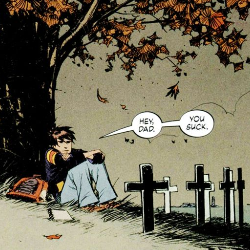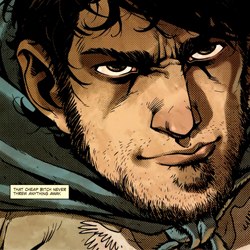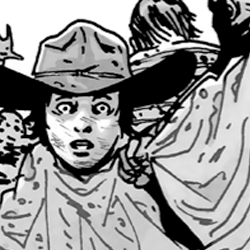When I’d read that this year’s Will Eisner Comic Industry Awards nominations contained a lot fewer superhero titles, I expected that the few that had made the cut would really shine out as stellar examples of the genre in the past year. Taking that into consideration, I was quite surprised to see “Superboy” listed for Best New Series. “Superboy“? Seriously? I’d read the first issue, and having been somewhat underwhelmed, had not bothered keeping up with the series. Seeing as it was given a nomination, I figured I’d catch up with Connor Kent and see what he’s been up to. Turns out, he’s been having to deal with a lot… though nothing out of the ordinary for a DC superhero. So why the nomination… Allow me to shed some light on what has transpired in the first five issues, and from there, you may come to your own conclusions. However before we start, just so folks don’t think me overly harsh due to some pre-conceived opinion of the character, allow me to say that I’m a huge fan of the Teen Titans. We’ve also been watching Young Justice on TV, and I loved the introduction of Superboy in the series. I think the character has been very well handled in Young Justice, making him one of the more interesting ones to see develop. I can’t say the same for this comic book series, however. Issue 1 starts with a narrative from Connor wherein he states how he wishes he could have had a childhood. Writer Jeff Lemire and artist Pier Gallo go with a cliched image of a boy, garbed in a superhero outfit, running through a field of wheat in Smallville. I do like that Lemire didn’t allow Connor to wallow in self-pity, but rather is forcing the character to mature quickly, accept his creation, while still granting him a wide berth for self-discovery. Almost immediately, Superboy is visited by Phantom Stranger who informs him that great peril is coming to Smallville, and that Superboy should prepare. Despite the fact that Superboy makes light of the “ominous, cryptic shtick”, it’s still a lame setup. Being told that danger’s afoot isn’t really all that suspenseful. Trouble does in fact arrive, in the form of the Parasite… though not before we’re forced to endure several painful panels of Connor Kent interacting with Lori Luthor (Lex’s niece) and Simon Valentine, who has discovered that Connor is in fact Superboy. This revelation should have been quite shocking, however the manner in which it was presented instead made it feel as though it was just an unimportant plot-point to be skimmed over immediately before the Parasite’s surprise attack. That said, apparently Connor needs some tips on keeping his secret identity, well, a secret. Ripping off your shirt in a barber shop full of people, revealing your Superboy black T-shirt, will not help you toward that goal. Overall, Issue 1 feels rushed. Although I will admit that the Parasite fight was well choreographed… still I would be remiss if I did not point out how disgusted Vince was with the fact that the Parasite was defeated by wheat. If the same attention to detail could have been used with the rest of the script, we’d have had a great comic. Though even then, I would not have given it an Eisner nomination. So let’s move on to Issue 2. Poison Ivy made an appearance at the very end of Issue 1, and I was very curious to see how this would pan out. I love when villains travel to new cities, and seeing Poison Ivy out of Gotham seemed like it may be fun. Before we go further however, allow me to shake my head, ever so slowly, toward Pier Gallo, for catering to the lowest common denominator when drawing Poison Ivy. Congratulations. Those anatomy classes paid off. You know how to draw an ass. This is something which I’ve discussed at length in a feature for my personal site (and I may yet import that feature into this site to stir up some comments). I’m tired of these costume designs and virtual camera angles that are meant only to titillate. Honestly, grow up. We have. Luckily this is not the norm in “Superboy“, otherwise I’d have given up on the series entirely and chalked it up as a young, pubescent boy’s series. As for Gallo’s style as a whole, I know I haven’t discussed it yet, but that’s because I’m torn. There are panels which blow me away… followed by, well let’s be honest, tripe. Overall, I’m not a fan of the style, however I can appreciate the man’s talent. Getting back to the story, the Poison Ivy content was brief, and quite obviously, predictable. Though she pretended to want to ally herself with Superboy for a greater good, she of course turned at the end… only to then be defeated by parasitic frogs. Seriously. Apparently, this shit can be made up. This issue served to add more suspense to the ongoing mystery. The entire reason for Poison Ivy’s visit is explained in the final page of Issue 2, and you’re left to wonder how everything is going to tie in together. This issue also further defines the working relationship between Superboy and Simon. It becomes quite obvious that the two are going to be working together more closely, though it’s difficult to tell whether it will be as an equally ranked duo, or as lead and apprentice. And lastly, the issue lays the groundwork for Smallville… so to speak. The recent battles have ripped the crops apart and Superboy feels it is his responsibility to see to it that the farmers do not suffer needlessly because of it. Still with me? A’ight then, let’s flip through the third issue and see what awaits us. If you were expecting a rational splash page for the third issue, you will be seriously disappointed, as you may be with the entire issue. It seems there’s a force at work that is causing everyone but Lori Luthor to pass out; or in Connor’s case, struggle with consciousness, staggering around to find the source of the psychic assault. It’s during these first few pages that Lori discovers that Connor is Superboy. He decides to remove his plaid button-down in the hall, revealing his black Superboy T-shirt and she hides from him upon seeing this. Again… seriously Connor… secret identity. Hell, at least Superman found a phone booth. We’re three issues in, and already two of your classmates have discovered your identity. But I digress. Issue 3 was entirely character driven. We see Connor giving Bart (Kid Flash) a call to setup a fundraiser race to raise money for the local farmers. We also see Connor telling Simon Valentine that their friendship must come to an end if their superhero partnership is to continue. Apparently Connor’s worried about folks figuring him out if they see Simon with both Connor and Superboy. But ripping off his shirt in public, that’s cool. /sigh This issue also introduced us to the time travelling physic (responsible for the initial collapse of the schools population); Sajan Mehra, codename Psionic Lad. You’d think that by 2216, they’d have given up on calling teenage boys “lad”, but apparently they’re stuck with that stupidity for hundreds of years to come. I’d like to say I’m interested in Psyionic Lad, or the Hunting Party which followed him to Superboy’s time, however I simply am not. There is nothing original here. We’ve seen these tired scenes time and time again over the ages (pun intended). Issue 4 starts with Psionic Lad and Superboy tackling the Hunting Party, only for them to leave “mysteriously” when Simon happens upon the fight. Apparently a CODE-1 is pretty heavy. From that point on, the rest of the issue is entirely character and story driven. There is not one panel of action. We get more information about Psionic Lad, only to find out later that it’s quite likely all a lie (sorry, uh, spoiler?). We also get some melo-drama between Connor and Lori. I understand that in a series that revolves around a teenager, you will get drama. That is to be expected, and in the hands of a sufficiently talented writer, it can still be engaging for an adult. However there’s a fine line between drama and melo-drama… and you have to be very careful how you dance upon that line. Too much melo-drama will make the adults who are reading simply sigh and roll their eyes. This issue also cemented my opinion of Gallo’s panel pacing, and the verdict is not good. I simply do not like how he arranges his panels. In some instances, it’s painful and destroys the story’s pace. You only realize how important this is when you see it done so poorly. Although that said, having read Issue 6 with art by Marco Rudy, I can see that this will be a problem which plagues “Superboy” for some time yet to come. The panel placement in Issue 6 was absolutely terrible… however we’ll leave that for a separate review, as we’re only covering issues 1-5 in this feature. Let’s just skip to Issue 5, which actually was my favorite. This issue sees Superboy racing Kid Flash around the globe in an effort to raise money for the farmers whose crops were devastated by Poison Ivy. The question though is haven’t we seen this all before? Now, some may argue that “Superboy” is paying homage to the original “Superman vs The Flash” issues… but to them I would argue; enough is enough. There comes a point where you are no longer paying homage, but rather being a lazy writer. Ironically though, and I hate to say it, this was still my favorite issue of the five. I enjoyed the camaraderie between Connor and Bart. I enjoyed their stupid race, and I chuckled at the outcome. Still, I wish Lemire could have been more original. In addition to the race, we also got some brief relationship moments between Superboy and the Teen Titans. Not much else occurs in this issue. Lori jumps the shark in terms of potentially finding an excuse for shifting toward the “dark side”. Her emotions seem completely unreasonable, though Lemire may be relying on teenage drama as a justification… or the “mysterious” alien artifact upon which she’s been dropping her cigarette ashes during her midnight smoke-breaks away from her catatonic mother. We’ll have to see in future issues. Or rather, you’ll have to see in future issues. I feel I’ve given this series a very fair chance, and taking everything into consideration, I’ve little but disappointment when thinking of where it’s been and where it appears to be going. Not only did they not “hook” me from the beginning, but they didn’t hold me when I forced myself to read more than I otherwise would have. Also, I routinely felt as though I was being force-fed regurgitated, cliched scripts… and I don’t have the time for that. If I’ve already read the same concept several times over the years, I’m not likely to want to sit through it yet again… and I certain don’t want to lay down any bills to add further issues to my collection. Honestly, I don’t know why this series was selected as a nominee in the Best New Series category for the Will Eisner Comic Industry Awards. I can think of many others, in the superhero genre, which have pushed the boundaries of what we have grown accustomed to. I strongly disagree with this nomination, and as a rating for the series as a whole, so far, the most I could give would be a 6/10. Perhaps a 6.5. I did not see any spark of potential, to tell you the truth. i imagined some, but that was from my own ideas of where the series should go…. not because of anything the writer created or suggested. Superboy (Issues 1-5) DC Comics Story: Jeff Lemire Art: Pier Gallo, Jamie Grant...
